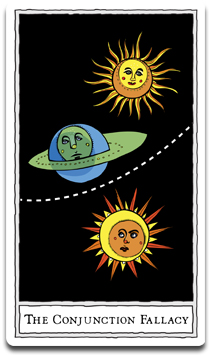 Which is more probable?
Which is more probable?
A: You decide to move to Greenland tomorrow.
or B: Tomorrow, you receive a phone call from an old friend who is in the same line of work you are in and he is currently living in Greenland working on an amazing project and needs your help and offers you a sweet job! Like the once in a lifetime job opportunity you simply cannot pass up, pays great, tons of vacation time, very rewarding, all that stuff. Later that evening after giving it some serious thought and talking it over with your surprisingly supportive friends and loved ones you decide that you are going to take the job and move there.
If you said B, you’d have fallen for The Conjunction Fallacy.
The Conjunction Fallacy occurs when someone assumes a more specific set of things is more probable than a more broad set of things.
Probably the most famous example of this fallacy is from Tversky and Kahneman.
Linda is 31 years old, single, outspoken, and very bright. She majored in philosophy. As a student, she was deeply concerned with issues of discrimination and social justice, and also participated in anti-nuclear demonstrations.
Which is more probable?
- Linda is a bank teller.
- Linda is a bank teller and is active in the feminist movement.
(Number 1 obviously, but I’m really rooting for number 2!)
Tversky, A. and Kahneman, D. 1982. “Judgments of and by Representativeness”, Pp 84-98 in Kahneman, D., Slovic, P., and Tversky, A., eds. Judgment under uncertainty: Heuristics and biases. New York: Cambridge University Press.
